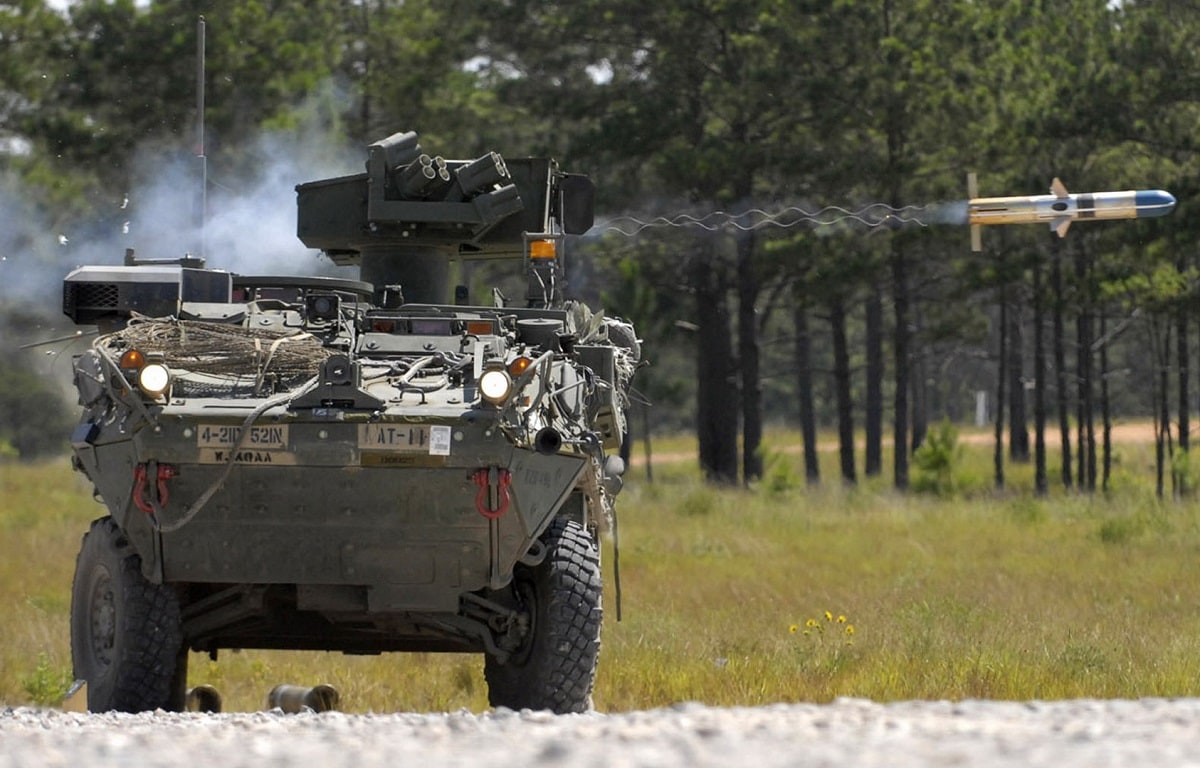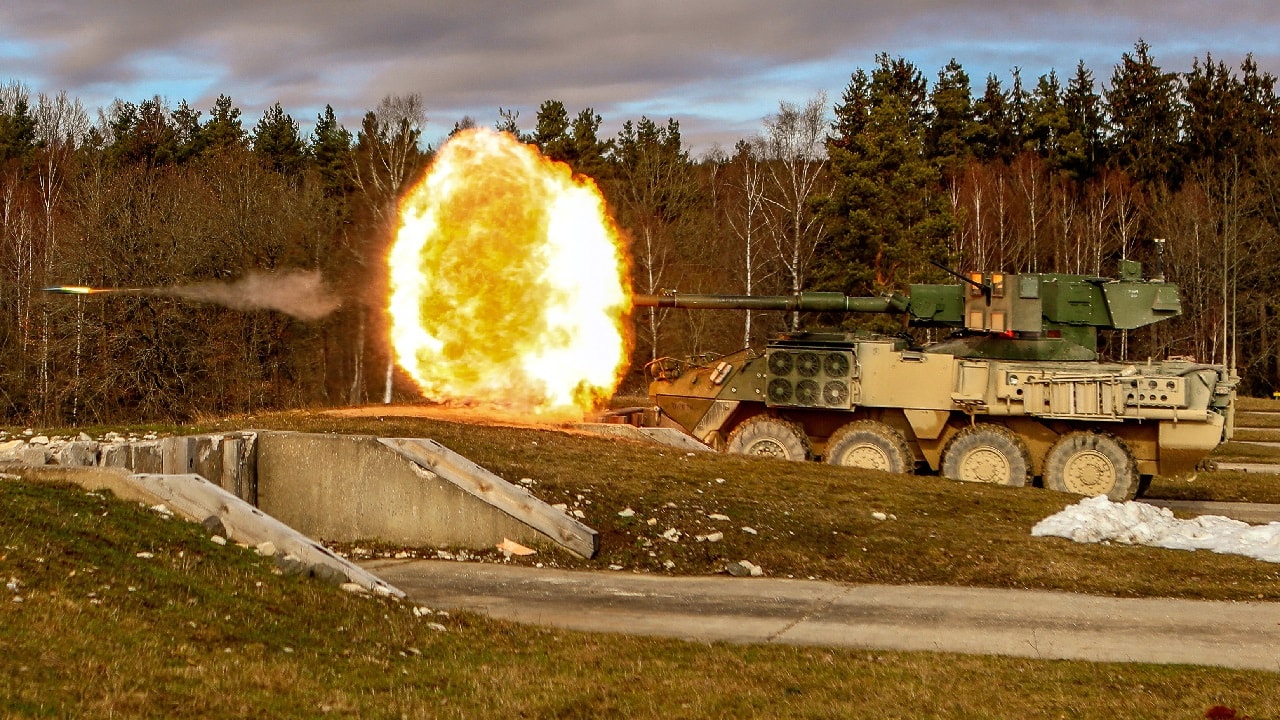The war in Ukraine has raged on since last year and we have seen what look like countless NATO and Western weapons sent to the battlefield to fight Putin.
Have them made an impact.
Well, looking at social media footage we can say for sure that they have – and they won’t stop making Russia pay anytime soon.
Fire! Stryker Armored Fighting Vehicles in Ukraine
A pair of American Stryker armored fighting vehicles were seen rolling down a dirt road in Ukraine in a video shared on social media last back in April.
The first of the two eight-wheeled vehicles was equipped with a moveable mine trawl installed in front to clear minefields at the time.
These Strykers could soon be engaged in combat with Russian forces – any might already be fighting.
Earlier this year, Washington pledged to send 90 of the armored fighting vehicles to Ukraine as part of a $2.5 billion military aid package. Combined with 50 Bradley infantry fighting vehicles (IFVs), the package was meant to provide Ukraine’s forces with the equivalent of two armored brigades’ worth of vehicles, The New York Times reported in January when the deal was announced.
Other recent videos shared on the Ukrainian Telegram channel Karymat and later re-uploaded to Twitter offered a brief look into the training that Ukrainian soldiers are receiving on the Stryker.
The Hard Hitting Stryker
The Stryker was originally developed in the late 1990s as a platform to form the backbone of new medium-weight brigade combat teams (BCTs) that were created to strike a balance between heavy armor and infantry.
There are currently 18 different variants of the vehicle – with some being built to primarily move infantry soldiers in and out of battle, while others were developed to carry a variety of weapons, including a 120mm mortar to provide fire support. Other models are also equipped with medium- and large-caliber weapons for direct fire on enemy forces.
Most variants are built on a common chassis to reduce the logistical footprint.
According to the U.S. Army, 10 flat-bottom variants have been produced, including the Infantry Carrier Vehicle (ICV), Mobile Gun System (MGS), Reconnaissance Vehicle (RV), Mortar Carrier (MC), Commander’s Vehicle (CV), Fire Support Vehicle (FSV), Engineer Squad Vehicle (ESV), Medical Evacuation Vehicle (MEV), Anti-tank Guided Missile (ATGM) Vehicle and Nuclear Biological Chemical Reconnaissance Vehicle (NBCRV). As those models proved vulnerable to improvised bombs, the Army has phased out those vehicles that are fitted with a “V-shaped” bottom similar to the military’s Mine-Resistant Ambush-Protected Vehicles (MRAPs).
There are now also seven Double-V-Hull (DVH) variants that include ICV, CV, MEV, MC, ATGM, FSV, and ESV, as well as an additional configuration of a modified ICV platform integrating a 30mm cannon.
Light and Versatile
Powered by a Caterpillar C7 engine, which provides 350 hp, the 8×8 wheel Stryker platform has an operational range of 500 km (310 miles) and can reach a top speed of 97 km/h (60 mph).
Though not providing the firepower or armor of a main battle tank (MBT), the Stryker – built by General Dynamics Land Systems – can operate in snow, mud, and sand, though its off-road mobility is more limited.
Yet, at 20 to 23.5 tons, the Stryker is still far lighter than a main battle tank (MBT) and thus could better handle the spring mud in Ukraine, which may explain why we’re seeing the first of the vehicles now rolling down the mud-soaked roads.
Pentagon officials have suggested it’s not a perfect solution, but Ukraine needs as many vehicles as it can get.
“Ukrainians need armored personnel carriers and short of other countries providing it, is what we have in inventory,” a DoD official told reporters in January, per Politico. “Not as good as a Bradley for a tank fight, but good to protect infantry and get up close to a fight.”

Image: Creative Commons.
It appears that Ukraine may now have a number of ICV variants in service, and those are capable of transporting a full squad of nine infantry troops. A ride in a Stryker would certainly beat a long walk down those muddy roads, while the vehicles can ensure that Ukraine’s Leopard 2 MBTs and other NATO tanks will have infantry support along for the ride.
Footage with the American armored personnel carrier Stryker in Ukraine. A movable mine trawl is installed in front. These structures are set to overcome minefields. pic.twitter.com/KiBaAnsBpz
— ???? Fertilizer Finder ???? (@ManiacMagic1) April 7, 2023
Author Experience and Expertise:
A Senior Editor for 19FortyFive, Peter Suciu is a Michigan-based writer. He has contributed to more than four dozen magazines, newspapers, and websites with over 3,200 published pieces over a twenty-year career in journalism. He regularly writes about military hardware, firearms history, cybersecurity, politics, and international affairs. Peter is also a Contributing Writer for Forbes and Clearance Jobs. You can follow him on Twitter: @PeterSuciu.

